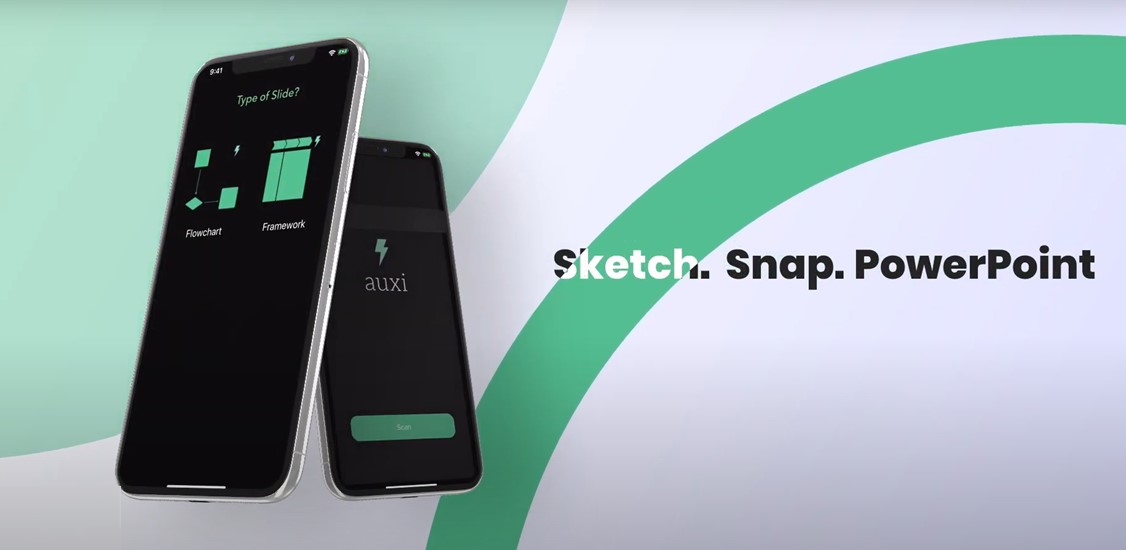auxi was started around 10 months ago. We realized that most knowledge workers, i.e management consultants, investment bankers, corporate employees, get hired to solve complex problems, but end up spending all their days formatting PowerPoint slides.
The best way to see auxi is as an AI productivity suite that one can install on top of the typical Microsoft Office or Google Docs suites. We are used to these tools and love them, and that's why everyone uses them. We just want to add a smart layer that works really well for our target customers, so that they can double their efficiency. Our first product is an AI bot that transforms handwritten sketches into fully formatted PowerPoint or Google Slides presentations. Company compliant, clean, beautiful, everything. You can edit the document and send it back and forth as usual. You can check it out here.
auxi has many of the top 15 management consulting firms as trial partners and a waitlist of thousands of users already. On the technical side, we stayed in stealth mode for a long while to make sure that the tech we envisioned can be built today. We didn’t want to overpromise and underdeliver, but quite the opposite. I have been involved in the startup scene for a few years now through companies I previously started and through a venture fund that I joined. I was fed up with AI companies building expectations and then failing on the implementation. I decided to build auxi the other way around. Revealing it only once the product was ready to be shipped.
It took us 9 months of trying to get the product to a valid stage. And when I say trying, I mean very smart people working hard every day, to solve the technical problems around detecting hand sketched items. It is a problem many people tried solving previously, but either couldn’t get it to work well enough or couldn’t commercialize it. We even had someone leave the company because he thought that there is no way this problem would be solved technically.
Today, the first product’s accuracy is good enough that it wouldn’t need new customer training data to get better. We take privacy very seriously and provide a hybrid cloud solution, where the customer data is stored on their end and we can’t access it. We also have a set of tools that deletes all critical and private information automatically from slides if we need to fine tune a model or extract features from a dataset of slides.
The app is currently at around 90% in terms of accuracy on flowcharts and frameworks. And in terms of recognizing text, as a general rule, if a human can read it, auxi should be able to. If auxi couldn’t recognize your handwriting, it would replace the text with a text box with ‘Enter text here’ so you can directly populate it in PowerPoint. Usually people do not write large amounts of text on pieces of paper but more of diagrams and interconnected shapes to present a framework or process flow. The automated transition from sketch, to fully formatted, company compliant PowerPoints is such a time saver that people would still use it even if it is at 60% accuracy, as you would have to build these shapes and text boxes anyway.


We see our main competitor as corporate templates. We have to be twice as fast, in copy, pasting and editing a slide template. And that's what auxi is.
We have a great team that gets things done. We have a limited meetings policy, where we prefer to build things instead of talking about things we plan on building. We are now close to 21 people with our summer interns and it is great to see the dynamic change, and the team expanding. We work hard to keep communication crystal clear and let the best ideas win no matter who they are coming from in the team. Managing AI projects and products is different from a typical software development process. Typically, if you are writing ‘normal’ software, development is often unidirectional. When you are building Machine Learning models and algorithms, it is more about trial and error. You would have to try the assumptions you have, see the results, keep notes of what you are changing in the data, in the model architecture, in the parameters and do it again. Once you reach a good stage then you can start building peripherals around it and make the model more compact so that you can run it with fewer resources on a cloud or locally.
It is true that AI is hyped, and that most problems can be solved with simpler technology. But we feel that it is time to see more real life applications. We believe that there are many opportunities out there for AI productivity applications, and this is only the beginning. We already have several other products in the pipeline, and hope that auxi will motivate other companies to get into the space and advance AI. We really get excited when we see real life problems being solved using Machine Learning. We have been humbled by the feedback and the demand. We get messages from people just sending thank you notes for making their lives easier, people we never met, or talked to. It feels great to see the impact of the technology we are developing, and to know that we are making work more enjoyable for so many people. Would recommend signing up at www.auxi.ai to get early access to our latest AI productivity tools.






















